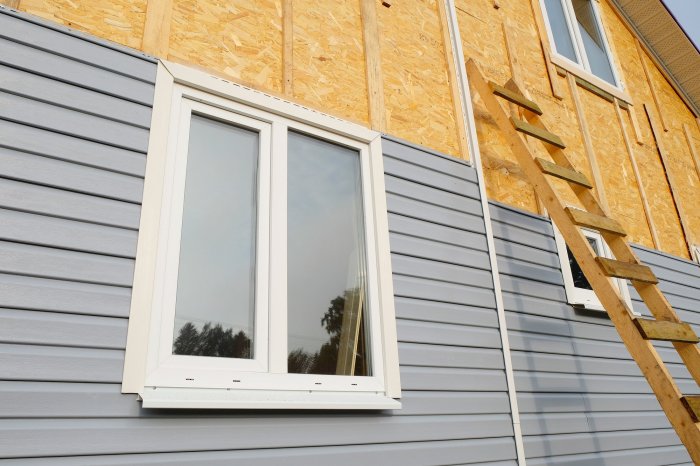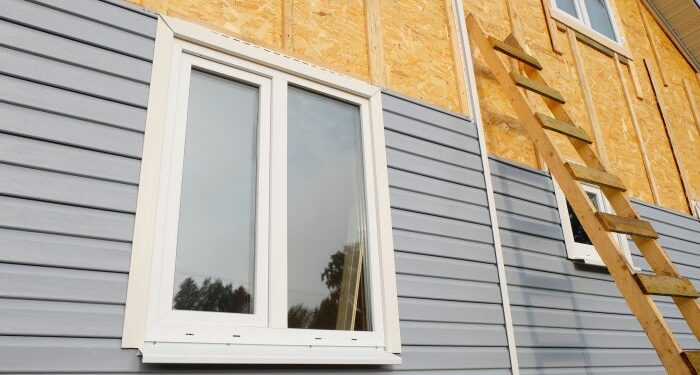Exploring the advantages of insulated vinyl siding for modern buildings, this guide offers a deep dive into the benefits, durability, design options, and environmental impact of this innovative material. Get ready to discover how insulated vinyl siding can transform your building project.
Benefits of Insulated Vinyl Siding
Insulated vinyl siding is a type of exterior cladding that is designed to provide additional insulation to buildings while also offering protection from the elements. This innovative material consists of vinyl panels with a layer of foam insulation attached to the back.
Advantages of Insulated Vinyl Siding
- Improved Energy Efficiency: The added insulation in insulated vinyl siding helps regulate indoor temperatures, reducing the need for heating and cooling systems to work overtime. This leads to lower energy consumption and utility bills.
- Enhanced Durability: Insulated vinyl siding is known for its resistance to harsh weather conditions, such as wind, rain, and extreme temperatures. It does not warp, rot, or corrode like traditional siding materials.
- Low Maintenance: Unlike wood or fiber cement siding, insulated vinyl siding does not require frequent painting or staining. It is easy to clean with just soap and water, saving time and money on maintenance.
- Versatile Design Options: Insulated vinyl siding comes in a wide range of colors, textures, and styles to suit any architectural design. It can mimic the look of wood, stone, or metal without the high cost or maintenance.
Cost-Effectiveness of Insulated Vinyl Siding
Insulated vinyl siding is a cost-effective option for modern buildings due to its long-term savings on energy bills and maintenance costs. While the initial installation may be slightly higher than traditional siding materials, the overall return on investment is significantly higher over time.
Additionally, the durability and low maintenance requirements of insulated vinyl siding contribute to its cost-effectiveness in the long run.
Durability and Maintenance

Insulated vinyl siding is known for its exceptional durability, making it a popular choice for modern buildings. It can withstand various weather conditions, including intense sunlight, heavy rain, and freezing temperatures, without deteriorating or losing its aesthetic appeal.
Durability of Insulated Vinyl Siding
- Insulated vinyl siding is resistant to moisture, preventing water damage and mold growth.
- It does not rot, warp, or corrode like wood or metal siding, ensuring long-term structural integrity.
- The color of insulated vinyl siding is fade-resistant, maintaining its vibrancy for years without the need for repainting.
Maintenance Tips for Insulated Vinyl Siding
- Regularly clean the siding with a mild detergent and water to remove dirt and debris.
- Inspect for any cracks, chips, or damage and repair them promptly to prevent further issues.
- Avoid using harsh chemicals or abrasive materials that can damage the surface of the siding.
Comparison with Other Siding Materials
- Unlike wood siding that requires regular painting and staining, insulated vinyl siding is virtually maintenance-free.
- Compared to metal siding that can rust or dent, insulated vinyl siding is more durable and resilient.
- Brick and stone siding may require occasional mortar repairs, while insulated vinyl siding maintains its appearance with minimal upkeep.
Value of Durability in Modern Buildings
Insulated vinyl siding's exceptional durability not only reduces maintenance costs but also enhances the overall value of modern buildings. Its longevity and resistance to wear and tear ensure a lasting and attractive exterior that adds curb appeal and increases property value
Design and Aesthetics
When it comes to the design and aesthetics of modern buildings, insulated vinyl siding offers a wide range of options to enhance the overall look and feel of the property. Insulated vinyl siding can be a versatile choice as it can mimic the appearance of traditional materials such as wood or stone, providing a sophisticated and timeless look without the high maintenance requirements.
Versatility in Design
Insulated vinyl siding comes in various styles, shapes, and sizes, allowing for endless design possibilities to suit different architectural preferences. Whether you prefer a sleek and modern aesthetic or a more classic and traditional look, insulated vinyl siding can be customized to meet your specific design needs.
Enhancing Curb Appeal
One of the key benefits of insulated vinyl siding is its ability to enhance the curb appeal of buildings. With a wide range of color choices and textures available, homeowners can easily customize the exterior of their property to create a welcoming and visually appealing facade.
From bold and vibrant colors to subtle and neutral tones, insulated vinyl siding can transform the look of any building and increase its overall attractiveness.
Color Choices and Textures
The color choices and textures of insulated vinyl siding play a significant role in the aesthetic appeal of a building. Homeowners can choose from a variety of colors to complement the architectural style of their property and create a cohesive design scheme.
Additionally, different textures such as smooth, wood-grain, or stone finishes can add depth and visual interest to the exterior, giving the building a unique and customized look.
Environmental Impact
Insulated vinyl siding offers several eco-friendly benefits that contribute to sustainable building practices.
Energy Efficiency
Insulated vinyl siding helps improve a building's energy efficiency by providing an extra layer of insulation. This reduces the amount of energy needed for heating and cooling, ultimately lowering carbon emissions and energy consumption.
Recyclability
Vinyl siding is a highly recyclable material, which means that old siding can be repurposed into new products instead of ending up in landfills. This recycling process helps reduce waste and conserves natural resources.
Green Building Certifications
Many insulated vinyl siding products meet green building standards and certifications such as LEED (Leadership in Energy and Environmental Design). This recognition signifies that the material has been manufactured in an environmentally responsible manner and contributes to a healthier indoor environment.
Comparative Environmental Impact
When compared to other siding materials like wood or aluminum, insulated vinyl siding has a lower environmental impact in terms of energy consumption, emissions, and waste generation. Its durability and recyclability make it a more sustainable choice for modern buildings.
End of Discussion
In conclusion, insulated vinyl siding emerges as a top choice for modern buildings due to its energy efficiency, durability, aesthetic appeal, and eco-friendly properties. Consider incorporating this versatile material into your next construction or renovation project for a long-lasting and sustainable solution.
Quick FAQs
Is insulated vinyl siding more cost-effective than other materials?
Yes, insulated vinyl siding is generally more cost-effective compared to materials like wood or stone due to its lower installation and maintenance costs.
Can insulated vinyl siding mimic the look of traditional materials?
Absolutely, insulated vinyl siding offers a wide range of design options that can closely resemble the appearance of wood or stone, providing a versatile and cost-effective alternative.
How does insulated vinyl siding enhance energy efficiency?
Insulated vinyl siding acts as a barrier against heat loss in winter and heat gain in summer, reducing the need for excessive heating and cooling, thus improving energy efficiency.
Does insulated vinyl siding meet green building standards?
Yes, insulated vinyl siding is eco-friendly and meets various green building standards and certifications, making it a sustainable choice for modern constructions.




